
EURASIP Journal on Advances in Signal Processing
Scope & Guideline
Pioneering High-Quality Research in Signal Processing.
Introduction
Aims and Scopes
- Signal Processing Theory and Algorithms:
This area encompasses the development of new algorithms and theoretical frameworks that improve signal processing techniques, including adaptive filtering, estimation theory, and statistical signal processing. - Machine Learning and Artificial Intelligence in Signal Processing:
The integration of machine learning and AI techniques into signal processing is a core focus, with research exploring applications such as deep learning for image and audio processing, as well as reinforcement learning for resource optimization. - Wireless Communication Systems:
Research on signal processing techniques for enhancing wireless communication systems, including MIMO, OFDM, and cognitive radio networks, is a significant emphasis, addressing challenges such as interference management and spectrum efficiency. - Biomedical Signal Processing:
This scope includes the processing of biomedical signals like ECG and EEG, focusing on methods for diagnosis, monitoring, and health assessment using advanced signal processing techniques. - Image and Video Processing:
The journal covers advancements in image and video processing methodologies, including image super-resolution, object detection, and video compression, highlighting innovative approaches for enhancing visual information. - Sensor Networks and IoT:
Research on signal processing for sensor networks and the Internet of Things (IoT) is highlighted, focusing on data fusion, localization, and smart city applications. - Remote Sensing and Radar Signal Processing:
This area involves the application of signal processing techniques to remote sensing and radar systems, including target detection, tracking, and imaging.
Trending and Emerging
- Deep Learning for Signal Processing:
There is a significant increase in research that applies deep learning techniques to various signal processing tasks, including classification, detection, and enhancement, showcasing the potential of AI to revolutionize the field. - Resource Optimization in Communication Networks:
Emerging research focuses on resource allocation and optimization strategies in communication networks, particularly in the context of massive MIMO and edge computing, addressing the growing demand for efficient data transmission. - Cybersecurity in Signal Processing:
The integration of cybersecurity measures within signal processing frameworks, especially in IoT and wireless communications, is gaining attention, reflecting the increasing need for secure communication solutions. - Multimodal Data Fusion:
Research exploring the fusion of data from multiple sources and modalities is on the rise, emphasizing the importance of integrating diverse data types for improved analysis and decision-making. - Real-Time Signal Processing Solutions:
There is a growing trend towards developing real-time processing algorithms and systems that can handle large datasets and provide immediate results, particularly in applications like autonomous systems and smart environments.
Declining or Waning
- Traditional Signal Processing Techniques:
There has been a noticeable decrease in publications focusing solely on traditional signal processing methods, as researchers increasingly integrate machine learning approaches to enhance performance and capabilities. - Simple Statistical Methods:
Research employing basic statistical methods for signal analysis is waning, as more complex and computationally intensive approaches, such as deep learning and advanced algorithms, gain traction. - Applications in Legacy Communication Systems:
The focus on older communication systems and methods, particularly those that do not leverage modern technology like IoT or AI, appears to be diminishing in favor of research that addresses contemporary challenges in communication.
Similar Journals
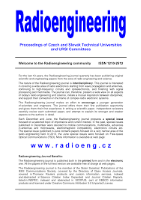
Radioengineering
Championing open access to transformative engineering insights.Radioengineering is a prominent academic journal published by SPOLECNOST PRO RADIOELEKTRONICKE INZENYRSTVI, focusing on the fields of electrical and electronic engineering. Established in 1992, this open access journal aims to disseminate high-quality research and innovative developments in radioengineering and related disciplines. With an inclusive readership from around the world, it has been integral in fostering advancements in technologies such as wireless communication, signal processing, and electromagnetic theory. The journal's commitment to accessibility is underscored by its open access policy, allowing scholars and practitioners to freely engage with the latest findings. As of 2023, *Radioengineering* holds a Q3 quartile ranking in its field with a Scopus rank of #500/797, placing it within the 37th percentile among its peers. Researchers, professionals, and students engaged in electrical and electronic engineering will find *Radioengineering* an essential resource for both theoretical insights and practical applications. For further information, submissions, and access to articles, please visit the journal’s site linked through the CZECH TECHNICAL UNIVERSITY, located in Prague, Czech Republic.

Traitement du Signal
Empowering Innovation in Electrical EngineeringTraitement du Signal, published by the INT Information & Engineering Technology Association, is a distinguished journal that serves the vibrant field of Electrical and Electronic Engineering. With an ISSN of 0765-0019 and an E-ISSN of 1958-5608, this journal has made significant contributions to the discipline since its inception. While it currently operates under a non-open access model, it maintains its commitment to disseminating valuable research from 2010 to 2023, despite its recent discontinuation in Scopus coverage. Recognized in the third quartile (Q3) of the category in 2022, the journal provides a platform for researchers, professionals, and students to publish their findings on topics such as signal processing, communications, and related technologies. By curating high-quality articles, Traitement du Signal plays a crucial role in advancing knowledge and fostering innovation within the electrical and electronic engineering community.
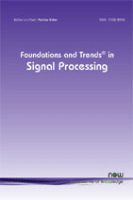
Foundations and Trends in Signal Processing
Shaping the future of Signal Processing through impactful research.Foundations and Trends in Signal Processing is a premier academic journal published by NOW PUBLISHERS INC, specializing in the dynamic field of Signal Processing. With an impressive 2023 Q1 rank in its category and a notable position of 3rd out of 131 in the Scopus rankings for Computer Science and Signal Processing, this journal stands at the forefront of research dissemination in its domain. Established in 2007, it has provided a platform for high-quality research articles that cover cutting-edge topics and emerging trends in Signal Processing, which is critical for advancements in areas such as communications, image processing, and machine learning. Although the journal operates under a subscription model, it offers a wealth of vital information aimed at researchers, professionals, and students alike, fostering a robust academic dialogue and enhancing the knowledge base within this important field.
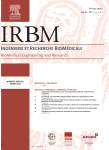
IRBM
Advancing Knowledge at the Intersection of Science and EngineeringIRBM, published by Elsevier Science Inc, stands at the forefront of research in the domains of Biomedical Engineering and Biophysics, boasting impressively high rankings with a Q1 category in both fields according to the 2023 evaluations. With an effective focus on cutting-edge innovations and methodologies, IRBM provides a vital platform for researchers, professionals, and students alike seeking to disseminate and access groundbreaking findings and developments. Its strong presence in the Scopus database, with ranks of #12 in Biochemistry, Genetics and Molecular Biology and #42 in Biomedical Engineering, places it in the top percentile of impactful journals in the field, making it a crucial resource for advancing knowledge and fostering collaboration. While the journal maintains a traditional subscription model, it continues to attract a diverse readership eager for insightful studies and reviews that push the boundaries of science and engineering. With a projected convergence of years extending to 2024, IRBM promises to remain a significant contributor to the ongoing dialogue in the life sciences.
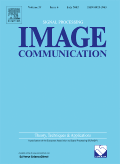
SIGNAL PROCESSING-IMAGE COMMUNICATION
Innovating Signal Processing for Tomorrow's TechnologiesSIGNAL PROCESSING-IMAGE COMMUNICATION, published by Elsevier, is a leading journal in the fields of Computer Vision, Signal Processing, and Electrical Engineering. With an impressive range of Quartile rankings in 2023, including Q1 in Electrical and Electronic Engineering and Q2 in Signal Processing, this journal is vital for researchers and professionals seeking the latest advancements and comprehensive studies in image communication technologies. Issued in the Netherlands, SIGNAL PROCESSING-IMAGE COMMUNICATION has been an essential resource since its inception in 1989, fostering innovation and collaboration among academia and industry. The journal provides a platform for high-quality peer-reviewed research, addressing significant challenges and solutions in the convergence of image processing and communication. Although currently not an Open Access journal, it offers subscription options that ensure a broad dissemination of groundbreaking knowledge. With a robust reputation reflected in its Scopus ranks, this journal serves as an indispensable reference for students and experts aiming to stay at the forefront of developments in this dynamic field.
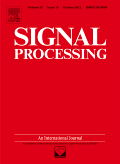
SIGNAL PROCESSING
Unlocking the Potential of Signal AnalysisSIGNAL PROCESSING is a premier academic journal published by Elsevier, dedicated to advancing the field of signal processing. With an impressive impact factor and ranked in the Q1 category across various disciplines such as Computer Vision and Pattern Recognition, Control and Systems Engineering, Electrical and Electronic Engineering, and more, the journal stands as a highly respected resource within the academic community. Since its inception in 1979, SIGNAL PROCESSING has provided a platform for researchers and professionals to disseminate their findings on innovative algorithms, techniques, and applications related to signal analysis and processing, making significant contributions to both theoretical and practical aspects of the discipline. The journal is accessible through institutional subscriptions, ensuring that scholars and students can engage with cutting-edge research and foster advancements in technology and methodology. Readers can expect to find a wealth of articles that promote critical discourse and facilitate further research, making SIGNAL PROCESSING an essential reference for anyone involved in the fields of signal processing and related areas.

EURASIP Journal on Wireless Communications and Networking
Empowering Research in Wireless CommunicationsThe EURASIP Journal on Wireless Communications and Networking, published by Springer, stands as a pivotal platform dedicated to advancing the field of wireless communications and networking. With an ISSN of 1687-1472 and E-ISSN of 1687-1499, this Open Access journal has been disseminating high-quality research since 2004, ensuring broad accessibility for scholars and professionals worldwide. Maintaining an esteemed position in the academic community, it is classified in the Q2 quartile for 2023 across critical categories including Computer Networks and Communications, Computer Science Applications, and Signal Processing. The journal's performance is reflected in its Scopus rankings, which place it in the 73rd percentile for Computer Networks and Communications and the 72nd percentile for both Computer Science Applications and Signal Processing. With a focus on innovative research and practical applications, the EURASIP Journal is an essential resource for anyone seeking to contribute to or stay informed in the dynamic landscape of wireless communication technology.

Frontiers in Signal Processing
Empowering Innovation in Signal ProcessingFrontiers in Signal Processing is a pioneering open access journal published by FRONTIERS MEDIA SA that has been a key player in the field of signal processing since its launch in 2021. With an E-ISSN of 2673-8198, this journal aims to foster innovative research and contribute to advancements in various signal processing applications, from audio and image processing to telecommunications and biometrics. As a platform for researchers, professionals, and students, it provides a rigorous peer-review process along with wide dissemination of high-quality articles, making groundbreaking findings freely accessible to a global audience. The journal’s commitment to open access ensures that knowledge is not confined by paywalls, thereby empowering the scientific community to accelerate discovery and learning. With a comprehensive scope that encompasses theoretical insights and practical applications, Frontiers in Signal Processing is poised to play a vital role in shaping future developments in this dynamic field.
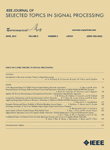
IEEE Journal of Selected Topics in Signal Processing
Shaping the Future of Signal Processing ResearchIEEE Journal of Selected Topics in Signal Processing is a premier academic publication dedicated to the advancement of knowledge in the field of signal processing. Published by IEEE-INST ELECTRICAL ELECTRONICS ENGINEERS INC, the journal boasts an impressive impact factor that places it in the top tier of its category; ranked Q1 in both Electrical and Electronic Engineering and Signal Processing for 2023. Given its esteemed standing, the journal serves as a vital resource for researchers, professionals, and students alike, providing cutting-edge insights and developments that shape the future of signal processing. The journal encompasses a wide array of topics relevant to the evolving landscapes of electrical engineering and computer science, with particular significance in innovative applications and methodologies. As a platform for disseminating high-quality research, this journal remains essential for those seeking to stay at the forefront of this dynamic field. You can explore the latest contributions and findings, benefiting from the journal's influential status in the realm of signal processing.

Journal of Signal Processing Systems for Signal Image and Video Technology
Exploring the Intersection of Technology and Methodology.Journal of Signal Processing Systems for Signal Image and Video Technology, published by SPRINGER, is a leading interdisciplinary journal dedicated to advancing research and development in the fields of signal processing, image processing, and video technology. With an ISSN of 1939-8018 and an E-ISSN of 1939-8115, this journal emphasizes both theoretical and practical applications, boasting a wide scope that ranges from control and systems engineering to hardware architecture. Since its inception in 2008, it has gained a solid reputation, reflected in its 2023 category quartile rankings—including Q2 in Control and Systems Engineering and Q3 in Signal Processing—demonstrating its significance within the academic community. The journal is underpinned by a commitment to open access, promoting broad dissemination of knowledge, and is particularly vital for researchers, professionals, and students looking to contribute to and stay updated in these rapidly evolving fields. With ongoing explorations into the convergence of technology and methodology until 2024, the journal stands as a crucial resource for the latest innovations and discussions in signal processing systems.